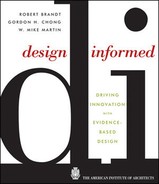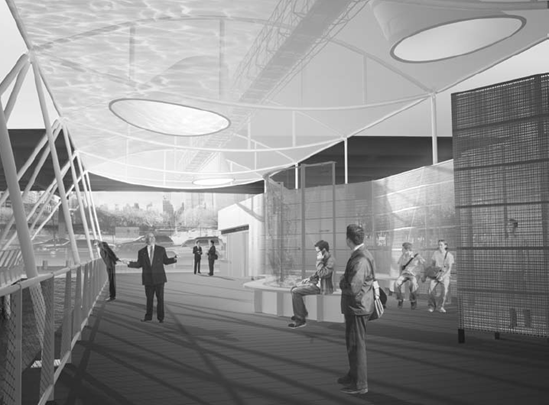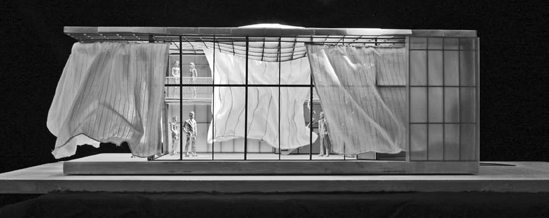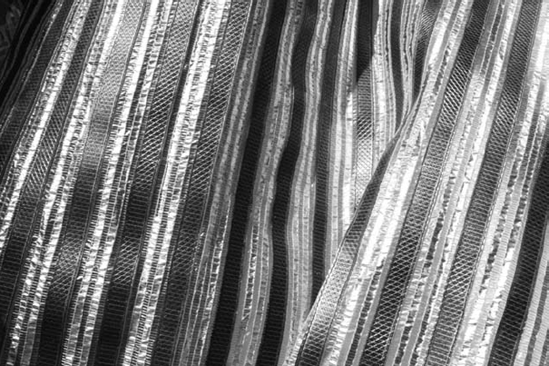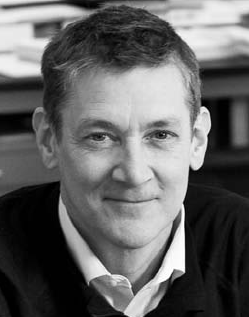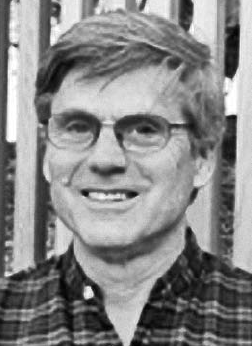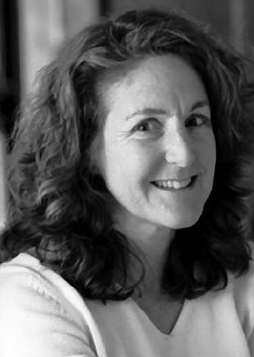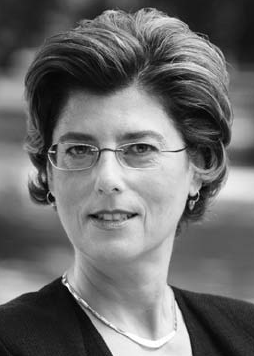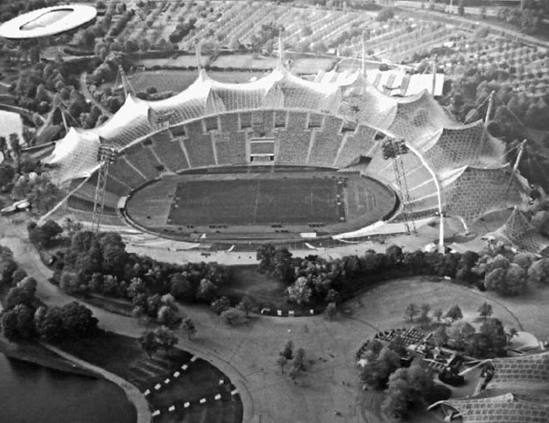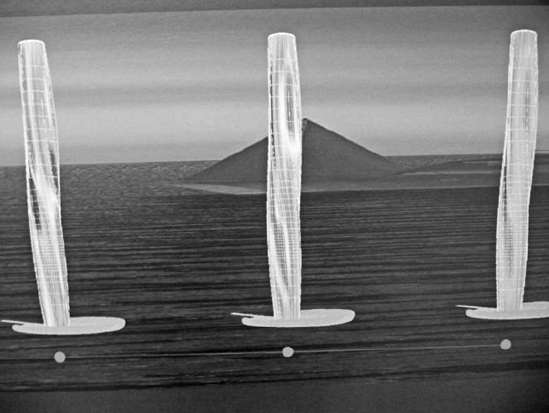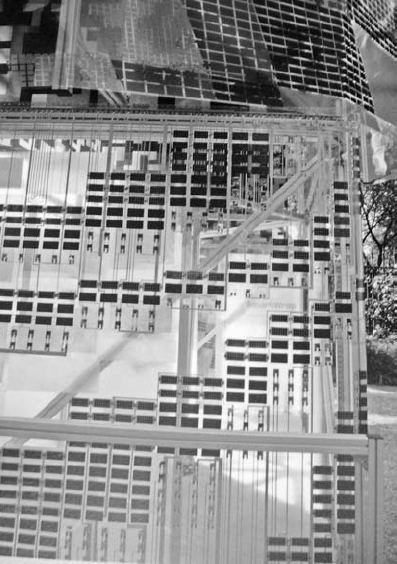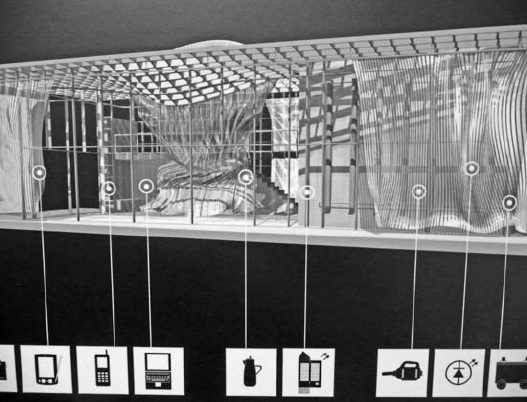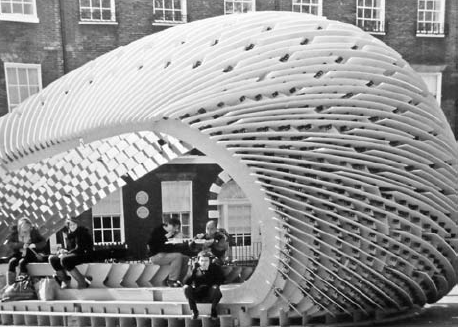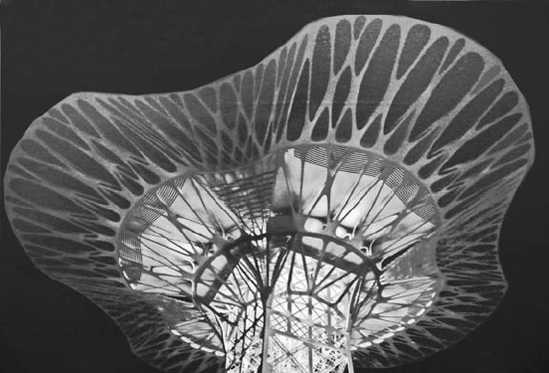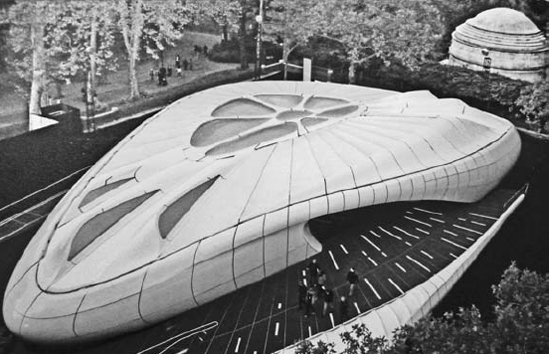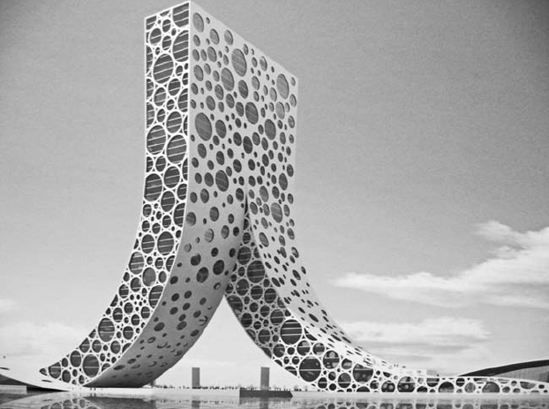
Architects, engineers, and contractors depend upon the advances in natural and physical science to inform contemporary design challenges, such as building systems performance, kinetic facade systems, the composition of new materials, structural seismic design, the structural and mechanical design of super tall structures, lighting, acoustics, climate response, energy management, and many aspects of sustainability. The architect's dependence on these sciences is deeply rooted in history and defines much of the essence of design.
Generally, the term "natural science" refers to biology and the earth sciences, while the "physical sciences" are astronomy, physics, and chemistry. This distinction between the natural and physical sciences is significant, relative to architecture.
Both of these broad categories of science have many specialized areas of study, among them botany, zoology, medicine, neuroscience, geology, geophysics, hydrology, astrophysics, geophysics, physical chemistry, and biophysics; as well as many cross-disciplinary endeavors, all focused on the study of the universe and the rules or laws of natural origin.
WITHIN THESE SCIENTIFIC DISCIPLINES, RESEARCH IN BOTH THE NATURAL AND PHYSICAL SCIENCES DEALS WITH THE VERY BASIS OF ELEMENTS—MATTER, MOLECULE, ATOMIC OR CELL STRUCTURE. AT THIS BASIC LEVEL, RESEARCH—COUPLED WITH THE LOGIC AND MATHEMATICS—USES A VERY STRONG FOUNDATION OF METRICS AGAINST WHICH OUTCOMES ARE EVALUATED.
The "hard sciences," especially physics and chemistry, rely heavily on the use of objective data, experimental and controlled processes, instrumentation, quantitative measurement, and repeatable methodologies. Recent technological advances in computation enable the manipulation of massive amounts of numerical data, reinforcing the potential of the hard sciences to produce highly compelling and credible research outcomes Even so, the scientific community continually scrutinizes research results for validity and reliability, knowing that no scientific process guarantees absolute proof or results that can be generalized to all situations.
The natural and physical sciences have specifically influenced architecture in terms of (1) the physics of structural interaction (forces, weight, mass, momentum, gravity, motion, energy transfer, principles of electricity and its source and properties); (2) the chemistry of material composition and material reaction; (3) the astronomy of the sun and solar system; (4) the biology and ecology of the land on which we build; and (5) the earth sciences including soil science, seismology, atmospheric pressure and winds, evaporation, condensation and humidity, hydrology, and precipitation.
PHYSICAL SCIENCE RESEARCH IS INTEGRALLY LINKED TO UNDERSTANDING "BUILDING PERFORMANCE."
Not surprisingly, the greatest innovation and advances in the architectural profession have traditionally been those having to do with building performance; using objective criteria, standard protocols, and metrics which are quantitatively definable.
BY CONTRAST, THE NATURAL SCIENCES PROVIDE INSIGHT FROM A BIOLOGICAL (WHOLE ORGANISM) PERSPECTIVE AND INFORM "HUMAN PERFORMANCE" IN BOTH QUALITATIVE AND QUANTITATIVE MEASURES. THESE QUALITATIVE MEASURES MAY BE MORE SUBJECTIVE BUT ARE CONSIDERED NO LESS VALID THAN THE QUANTITATIVE, OBJECTIVE MEASURES.
Specific examples of the influence of physical sciences on architecture can be seen in the work of institutes, product manufacturers, governmental testing agencies, and private testing institutions, most of which utilize instrumentation to simulate, test, and analyze issues such as natural and artificial lighting, thermal comfort; air flow; noise levels; seismic motion"; and strength of materials and product and building systems standards for fire, toxicity, and life safety performance. Historically, much of this research is oriented toward understanding the performance of building systems and materials.
Recently, the use of computer technology for visualization, simulation, cost and energy modeling, computation and integration of information has significantly advanced as a means of providing evidence in the form of building performance data for use in the design process.
In Chapter 1 Figure 1.1, we spoke about the importance of a future where design could positively influence human well-being and effectiveness, in addition to our current focus on the science of building performance. In this new world, we would better anticipate how people would respond to specific environmental stimuli such as lighting, spatial form, and sound; and how human behavior might be affected by environmental attributes. NEUROSCIENCE HOLDS THE KEY TO THAT UNDERSTANDING. Today we have the social sciences to understand human behaviors. Tomorrow, we will look to neuroscience to predict physiological responses to environmental stimuli and use that knowledge to design places that stimulate desired responses
FOR THE NEAR FUTURE, PHYSIOLOGICAL RESEARCH RELATED TO ARCHITECTURE WILL PROBABLY BE UNDERTAKEN IN COLLABORATION WITH SCIENTISTS OR IN AN ACADEMIC SETTING, RATHER THAN WITHIN A DESIGN FIRM. Just as many firms specializing in the design of health-care facilities currently employ individuals trained as nurses, physicians, and health-care administrators, in the near term neuroscientists will become members of design teams. We're already seeing a new generation of individuals dually educated as architects and neuroscientists entering the profession.
WHAT IS NEUROSCIENCE AND WHAT MIGHT NEUROSCIENTISTS AND ARCHITECTS HAVE AS COMMON INTERESTS?
Neuroscience is rooted in the biological sciences and has recently evolved dramatically due to revolutions in molecular biology, electrophysiology, and computational science. The discipline of neuroscience is often referred to as a study of the brain: more precisely, neurobiology is the study of the biology of the nervous system, and neuroscience is the science of mental functions that form the foundation of the constituent neural circuitries.
NEUROBIOLOGISTS ARE WORKING TO GAIN A GREATER UNDERSTANDING OF HOW NETWORKS OF NEURONS PRODUCE INTELLECTUAL BEHAVIOR, COGNITION, EMOTION, AND PHYSIOLOGICAL RESPONSES. IN THE CONTEXT OF ARCHITECTURE, THAT UNDERSTANDING IS RELATED TO THE RESPONSE OF EXPERIENCES AND ENVIRONMENTAL STIMULI CAUSED BY LIGHT, ACOUSTICS, SCALE, TEXTURE, AND OTHER DESIGN ELEMENTS IN THE KIT OF PARTS USED TO CREATE PLACES.
Three significant aspects of neuroscience research make it possible to comprehend how architecture and physiology interact.
Anatomy of the brain: A long-standing understanding of the anatomy and function of the brain, the senses that relate to architectural stimuli such as vision, hearing, movement, and cognitive functions
Imaging technologies: Recent imaging technologies that permit an ability to see which portions of the brain are "firing."
Neuroplasticity: Current discoveries about neuroplasticity, which examine the cause and effect of cell regeneration; their responses to environmental stimuli—such as light, noise, and vision— are of interest to both neuroscientists and architects.
Mapping the Mind, by Rita Carter, provides one of the best foundations for nonscientists in understanding the brain, mind, and consciousness. Carter reminds us of the relationship between the anatomy of the brain and its functions. These functions relate to the same senses that concern architects:
The parietal lobe: critical to movement, orientation, calculation and certain types of recognition
The temporal lobes: responsible for sound, speech, comprehension, and some memory
The frontal lobe: responsible for integrative functions, thinking, conceptualizing, planning, and conscious appreciation of emotion.
Carter emphasizes the complexity of the brain's two hemispheres covered by a cerebral cortex; the "little brain" known as the cerebellum; the 100 billion neurons with its dendrites, axons, and synapses; and the interior corpus callosum, which shunts information between the left and right hemispheres.
Carter also provides an understanding of the limbic system, which includes the:
While the individual parts of the brain have been well documented, a greater understanding of which portions of the brain "fire" in response to environmental stimuli—has been enabled by new scanning technology. These include:
Magnetic Resonance Imaging (MRI): MRI, in combination with a software system called a computerized tomography, works by aligning atomic particles in the body tissue by magnetism and then bombarding them with radio waves.
Functional MRI (fMRI): Neuronal firing is fueled by glucose and oxygen, which are carried in blood. When an area of the brain is fired up, these substances flow toward it and the fMRI shows the areas where there is most oxygen.
Near-infra-red Spectroscopy (NIRS) : Measures fuel being used at any moment by the brain
Electroencephalography (EEG): Measures brain waves—the electrical patterns created by the rhythmic oscillations of neurons
ALL OF THESE TECHNOLOGIES PROVIDE IMAGES AND COMPUTATIONS OF WHAT IS HAPPENING IN THE BRAIN WHEN EXPOSED TO SPECIFIC STIMULI, IDENTIFYING WHAT PORTIONS OF THE BRAIN ARE RESPONDING AND MEASURING THE EXTENT OF THAT EXCITEMENT.
Norman Doidge, in his book titled The Brain that Changes Itself, speaks about recent discoveries that show that THE BRAIN'S ANATOMY IS NOT FIXED BUT IN FACT CELLS ARE CONTINUALLY CHANGEABLE, MALLEABLE, AND CAN BE MODIFIED. This concept of "neuroplasticity" has opened an entire field of study to understand what kinds of stimuli cause these changes to occur and to find practical (medical) applications for regeneration of cells. Using the scanning technologies and computational science, a fascinating field of exploration is engaged in linking stimuli to response. Because many of the stimuli such as light, sound, smell, touch, vision, and perspective are of mutual interests to neuroscientists and architects, future collaborations between the disciplines present exciting opportunities.
In her most recent book, Healing Spaces...the Science of Place and Well-Being, Dr. Esther Sternberg explores the relationship between neuroscience and architecture through seeing, sound and silence, touch and smell. She notes: "Thus we use vision, smell, and touch to gather information about our surroundings. Each sense detects individual features of what we perceive. Our brains then integrate these features in time and space to create a three-dimensional, richly colored, stereophonic, and scanned image that tells us where we are. The sense-pictures change constantly as the world alters around us at every moment of our lives. And in response, the brain continuously uploads the new information and incorporates it into constantly revised versions of our world."
With advances in the field of neuroscience, new disciplines such as neurolaw and neuroeconomics have evolved. Many architects credit John P. Eberhard, FAIA, with being the founder of another new discipline, neuroarchitecture. A researcher, architect, and educator, Eberhard is a serious student of neuroscience and describes its relationship to architecture in his books Architecture and the Brain (2007) and Brain Landscape (2008). In addition to his role as knowledge leader and father of this new discipline, John Eberhard is the founder of the Academy of Neuroscience for Architecture (ANFA) in San Diego. To encourage neuro-architecture research, ANFA has brought together architects and environmental psychologists, such as John Zeisel, with neuroscientists, including Drs. Fred Gage and Tom Albright of the Salk Institute; Dr. Eduardo Macagno of the University of California, San Diego; Dr. Steve Henricksen of Western University of Health Service; and Dr. Esther Sternberg of NIH; and industry leaders, such as Joyce Bromberg of Steelcase, and educators, including Gil Cooke, Dean of the New School of Architecture in San Diego.
Through these efforts, a new generation of professionals educated in joint architectural-neuroscience programs is being developed. ANFA continues to foster research opportunities and linkages between the two disciplines of neuroscience and architecture.
The research methodologies, protocols, and (peer review) standards used in the natural and physical sciences are similar to the traditional ten steps discussed in the previous chapter on social science. Perhaps the primary differences from the social science in methodology are:
Greater dependency on controlled laboratory experiments;
Highly specific, defined, and focused experimentation;
Greater use of instrumentation;
Consistent use of quantitative metrics;;
Laboratory experiments scaled to smaller samplings in "controlled and blind" settings;
Consistent isolation and manipulation of individual variables; and
Consistent ability to replicate the experimental conditions.
Aided by the nature of rigorous research in laboratory settings, much of the research related to architecture is focused on singular aspects of human response to environmental stimulus within a limited contextual circumstance. For instance, for the 2005 AIA Latrobe Fellowship by Chong Partners Architecture, the University of California, Berkeley, and Kaiser Permanente, undertook a study of the effect of a very specific controlled, and defined, lighting condition on heart rate variability as an indicator of stress under a specific contextual setting.
The physical sciences provide valuable insights into design approaches for enhanced building performance and new materials to address sustainable design challenges. However, critics complain that the research is limited in design application, since the method focuses on but one piece of the solution to a whole building system. (The hard sciences are known for their reductionist approaches to research and experimentation.)
A single research finding alone can rarely accurately inform applied building design, which is influenced by a confluence of issues. For example, the use of a new material developed from chemistry is highly dependent upon the physics of its application to determine true utility. Nonetheless, natural and physical science experimentation is creating highly relevant evidence of relationships between individual design elements and performance outcomes in specific contexts.
CURRENTLY, THE MOST PROLIFIC AREA OF INNOVATIVE AND APPLICABLE RESEARCH LINKING SCIENCE AND DESIGN IS THE EXPLORATION OF DESIGN STRATEGIES TO INCREASE ENVIRONMENTAL SUSTAINABILITY.
In contrast, today there is little substantive research in neuroscience to dependably link a specific environmental stimuli to a specific human response. But we have confidence it will come and prove itself to be exceptionally compelling. As a larger database of research is developed, neuroscience will provide credible evidence of human response to environmental stimuli within a specific context.
The following interviews provide insight into how scientists and architects are utilizing knowledge gained from the natural and physical sciences to inform design. Their work falls into three categories:
Sheila Kennedy is a founding Principal in the Boston firm of Kennedy and Violich Architecture, Ltd. (KVA) and Design Director of its materials research unit MATx. Designated as one of Fast Company's Masters of Design, Kennedy is described as an insightful and original thinker, who is "designing new ways of working, competing, learning, leading and innovating." Kennedy's work was featured in "Design and the Elastic Mind," MOMA's exhibition on breakthrough designs for new technologies and she is the first woman to hold the position of Professor of the Practice of Architecture at MIT.
In 2000, Kennedy established MATx, a pioneering materials research unit at KVA to engage applied creative production across the fields of electronics, architecture, design, and material science. MATx explores how design can leverage the formal, aesthetic, and technical properties of digital technologies and new materials to accelerate their entry into the building industry and meet the needs of different cultures around the world. MATx has developed designs and technology applications for Dupont, Siemens, Osram, Herman Miller, Saint-Gobain, The North Face, and the United States Department of Energy. The MATx Portable Light Project, a nonprofit global initiative to create energy-harvesting textiles in the developing world, has been recognized with a 2009 Congressional Award, a 2009 Energy Globe Award, and a 2008 Tech Museum Award for technology that benefits humanity.
Kennedy's research and work in architecture has been recognized by grants from the National Endowment for the Arts and the National Academy of Sciences. She is the author of seven patents for the integration of digital technologies in architecture, building materials, and textiles, and has served as an advisor to the U.S. Department of Energy, the National Academy of Sciences' Government-Industry Partnerships, and the Vision 2020 National Technology Roadmap. Her work has been exhibited at many international design venues and has been featured in journals of architecture, design culture, anthropology, and optoelectronics, as well as on National Public Radio, BBC World News, CBS News, CNN Principal Voices, Wired Magazine, Science News, The Economist, The Wall Street Journal, BusinessWeek, and The New York Times.
Kennedy and her colleagues put MATx research into practice through the creation of a new model for practice which brings a digital fabrication workshop, an optoelectronics lab, and an architecture and design studio under one roof. The firm's headquarters is located in the former Blue Bird Bottling Plant in Boston's emerging NewMarket District. The KVA MATx studio was selected by I.D. Magazine as one of the top 40 creative global workplaces.
Your practice is known for its integration of research and design. Can you tell us how you develop your research and how it is reflected in your design?
As a design firm, we are primarily interested in creating ideas and developing processes that enable us to realize these ideas in practice. Innovation in architecture requires a reconsideration of the relationship between design and production processes. Since there are budget and schedule constants for any given project, we take on a double responsibility to create the project's design and to design how the product will be realized.
We launched our materials research unit MATx in 2000, because we realized that the need to design and integrate energy-efficient digital technologies in building projects places a great demand for vertical integration in architecture. We saw the potential to integrate new forms of infrastructure into materials, buildings, and cities. We realized that we needed to develop a model of practice which would allow us to organize (and often even create) the building products, technologies, and services that were necessary to realize important environmental parameters in the given needs of a project. This has led us to become the interdisciplinary organization we are today. And it has shaped the physical organization of the studio space where we work. At KVA MATx we renovated an industrial warehouse to suit our needs. We developed a stacked open studio floor plan where digital design and modeling are in close proximity to our materials library and where our optoelectronics "skunkworks" can flow into flexible project rooms and fabrication workshops. We have literally created a studio space which enables us to integrate research and design.
Our research often explores how to make the best use of young and sometimes underperforming new technologies. Our interest in making things has led us to combine new materials with familiar materials such as brick, glass, or textiles. By combining new technologies with traditional materials the fundamental nature of both "old" and "new" materials is transformed. By creating integrated, composite materials and building components—that provide new capabilities—we can move on past the modern architectural distinctions between "high" and "low" or "smart" and "dumb" technologies.
There is an important distinction between the meaning of "research" and "evidence."Research is the process of looking or searching for different solutions. Evidence suggests that something is evident or obvious, that it is already seen in relation to a given problem. For us, design always begins with research, with the task of searching to define a given problem and to discover different ways that it can be addressed in design. The importance of intuition in the creative process can't be underestimated; it is one of the major assets of architecture as a creative discipline. As a starting point, we outline hunches, then test our intuitions by working with a process of rapid prototyping and by examining the basic implications of an idea and checking it against our experience and what is already known.
We often separate various strands of the problem in a series of different prototypes, one for structural functionality, for example, and one which brings a quality of space or experience. We undertake a variety of empirical tests using both digital and physical models. Later in the design process these strands will be integrated once each is more clearly defined.
How important is it to be credible in describing value? Do you use metrics?
Credibility is developed over time. But a radical idea will not be automatically accepted based on past experience or credibility. However, if people can see or touch something, and use it—live with it for awhile—changes in habits of thought and practice can happen.
It is important to create a value proposition. However, value can be described in many ways—equity, political, social, and cultural. These are significant values which are often not easily monetized. Architects can emphasize value in the full terms of our discipline; by understanding the relationships between spatial, aesthetic, experiential, and technical aspects of issues such as energy conservation, life span, and efficiency.
As architects we should not be attempting to promote design using metrics. It would be naïve to think that numbers and statements used in metrics are purely factual or even objective; they are created according to various perspectives. We don't start with, nor do we focus our design process on metrics—we try to develop designs that emphasize qualities that are unique to the medium of architecture; the use of light, the sensory experience of materials, the way a material surface or a space can engage the passage of time.
Can you give us some examples of how your research has informed your design?
KVA has recently completed Harvard's new Film and Video Headquarters, RISD's Graduate Arts Center, and the University of Pennsylvania's Motion Capture R&D Labs. Their design of the East River Ferry Terminal Building at 34th Street in Manhattan, currently under construction, received the New York City Art Commission Award for Design Excellence, and is the first public sector project in Manhattan to be realized with digital fabrication.
The 34th Street Ferry Terminal in New York is an example of how budget and site served as catalysts for innovation. A traditional steel roof structure proved too expensive, due to staging problems on a congested urban site. In collaboration with Michael Stein and our structural engineering team at SBP, our design developed a novel double-sided stressed skin textile roof that reduces the need for steel trusses and can be fabricated offsite, so a high degree of fabrication quality can be maintained on this public project.
One of the most interesting aspects of this project involved creating a cooperative set of performative surfaces that work together in an affordable way to provide a first instance of distributed infrastructure in a public building. The lower fabric roof layer is made with a reflective metal mesh which is intersected by light wells that provide daylight to information and seating areas below. We developed a way to integrate LEDs in the light well surfaces to provide illumination and responsive signaling capabilities that monitor weather and ferry boat arrivals and departures. Using only off-the-shelf sensors, and industrial rugged foot step switches, we designed benches with energy-efficient passenger heating on demand. The design of distributed heating, artificial lighting, and daylighting in architecture is a key transition away from modern centralized building services. This strategy accelerates the use of new energy-efficient technologies and we find that our research investment returns many times over as we can apply what we've learned to new projects.
Since 2000, the team at KVA MATx has been working with semiconductor materials that harvest energy and emit light. In our SOFT HOUSE project, we have been working with manufacturers of solar nano-technology which can be printed on flexible, thin-film substrates using an organic dye. We are developing ways to integrate this new material into solar textiles for energy-harvesting building curtains, façade, and roof canopy systems. One of the interesting aspects which emerged in this project was the need to challenge and redefine the terms of efficiency metrics that have been used by the glass solar panel industry for the last decade.
The solar roof panel industry is based on the use of "peak efficiency" metrics, which describe the energy generated at peak hours when sunlight is perpendicular to the panel. Solar nano-materials are a disruptive technology. The organic photovoltaic materials used in SOFT HOUSE solar textiles are very inefficient in relation to traditional glass panels. However, they are very inexpensive to manufacture, and their production process uses far less embodied energy. Their value lies in their ability to convert sunlight into energy all day long, so we need to introduce a new idea of accrued total daily energy. Though less familiar as a metric, the total energy produced is what is important and also the fact that the energy-manufacturing process is clean and it is well known that most companies don't produce metrics on embodied energy in production.
The work of KVA has shown that the use of research and high-quality design are not inconsistent but in fact are integrated and dependent. What changes to our academic curriculum and practice models do you think are needed to encourage comparable innovation in the future?
We need to be working more with materials, (physical) models, and memory—the memory of what has already been accomplished in the discipline. Ironically, the parametric software and CAM tools that allow us to begin to consider questions of emergent digital materiality also have the potential to distance architects from the day-to-day considerations of contemporary practice. Construction in practice requires the fluid movement from the virtual 3D digital model to a projected, flat 2D drawing schedule of parts which are then assembled into a 3D physical constructed reality. Digital machine outputs in building practices require the architect to work directly with the material/machine interface and be much more adept at understanding and predicting material performance. Yet in many schools, 3D printing and the segregation of studio, classroom, and workshop are beginning to erode the architect's ability to make things, to understand the resistance of materials.
Architects need to continually invent strategies for relevancy without giving up the realm of architecture's unique areas of creative expertise. We need a formulation of research with a continuum between basic (core disciplinary) research and applied research, where one leads back to the other. Historical research and precedent are increasingly important—it is not the first time that our culture is experiencing significant changes in infrastructure and in the physical environment. This requires the architect to scrutinize the problems of the present with a better understanding of history without compromising her or his ability to imagine alternative futures. What do we want to achieve? What can we do right now, with what we already have? How can this help us create better futures? The best projects of architecture are those that have the ability to move between the future and the present to transform the discipline from within.
KVA was commissioned by the New York City Economic Development Corporation (EDC), the New York City Department of Transportation (NYCDOT), and the New York City Parks Department (NYCDPR) to design the East River Ferry Project in Manhattan. This major urban waterfront transportation initiative includes the design of an intermodal ferry terminal at East 34th Street as well as ferry boat docking facilities, waterfront improvements, and community amenities on six sites along the East River waterfront in Manhattan. The project expands regional waterway causes by accommodating high-speed ferry service to La Guardia Airport, Staten Island, Brooklyn, Queens, and New Jersey. The design encourages public use of the waterfront through pedestrian, train, bike path, and vehicular connections from the City to the riverfront, offers commuters an alternate and sustainable means of transportation within Manhattan, and serves as a public safety corridor in times of emergency.
The design of the 34th Street Ferry Terminal takes a nonnostalgic attitude toward the NYC riverfront. Pier 34 is redesigned and expanded to provide passengers with ticketing and waiting facilities and public access to three high-speed ferry berths. KVA secured grant monies from New York State agencies for off-grid sustainable energy generation including hi-torque urban wind turbines and solar-powered solid state lighting. The architecture integrates information from New York City's existing and underutilized maritime GPS to provide electronic way finding signage, intelligent real-time transportation scheduling (ITS), wireless public messaging, and information access systems for commuters and waterfront residents.
The Ferry Terminal uses an innovative tensile textile roof structure which is fabricated offsite and erected in a matter of days to provide an efficient approach to building delivery on this urban site. An upper layer of structural PTFE fabric provides 15 percent translucency and the lower layer of reflective mesh bounces light reflected off the water surface, providing a natural play of light by day and avoiding the need for costly site lighting. On-demand integrated radiant heating is provided in the passenger waiting area. Further, the area is protected from windblown rain by retractable weather screens.
The 34th Street Ferry Terminal creates a public architecture which juxtaposes the natural and artificial qualities of the East River Waterfront with the project's sustainable digital technologies. The building's cross-section is detailed so that the terminal appears to be suspended above the water—the sound of the river and the reflective capacity of the changing water conditions at high and low tides are engaged by the surfaces of the architecture. The physical experiences of the waterfront environment are combined with the expanded virtual experiences of the working commuters: GPS, cell phone, and Internet.
The Soft Energy Path, presented by Amory Lovins at the Rocky Mountain Institute in 1978, outlined the value of multiple and hybrid approaches to reduce mainstream consumption of nonrenewable energy sources. Drawing upon these principles, the SOFT HOUSE research group, a team of architects, engineers, fabricators, and manufacturers organized by KVA MATx, created a prefabricated house design where the performance and material potentials of disruptive organic photovoltaic (OPV) nano-technology could succeed without having to compete with the dominant technology of the electric grid.
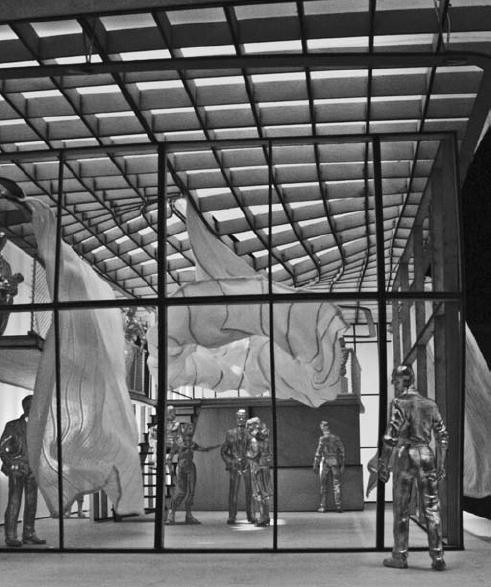
Figure 4.2c. Soft House Model: Perimeter curtain moves outdoors to provide shade and harvest sunlight. Raised central curtain creates open floor plan.
The SOFT HOUSE by KVA MATx transforms the household curtain into a set of energy-harvesting and light-emitting textiles that power solid state lighting and portable work tools such as laptops, digital cameras, and PDAs. SOFT HOUSE textiles can adapt to the changing space needs of homeowners and can be moved to follow the sun generating up to 16,000 watt-hours of electricity—more than half of the daily power needs of an average household in the United States. KVA MATx was commissioned by the Vitra Design Museum to realize full-scale prototypes of the SOFT HOUSE energy-harvesting textiles for the exhibit "Open House: Architecture and Technology for Intelligent Living."
KVA MATx application designs for energy-efficient semiconductor technologies in movable curtains, translucent textile screens, and luminous room enclosures shift the boundaries between the traditional wall and household utilities. The SOFT HOUSE distributed energy network is made of multiple, adaptable, and cooperative light-emitting textiles that can be touched, moved, and used by homeowners according to their needs. Translucent movable curtains along the SOFT HOUSE perimeter convert sunlight into energy throughout the day, shading the house in summer and creating an insulating air layer in winter. A central curtain moves vertically to create an energy-harvesting chamber or a suspended soft chandelier with integral solid state lighting.
The principles of the SOFT HOUSE energy network—simplicity, adaptability, and intelligent cooperation among individual elements—are extended into the architectural design and fabrication of the SOFT HOUSE. The grid shell plywood structure of the SOFT HOUSE can be adapted to accommodate a range of different site and solar orientations in a digital design and fabrication process. Parametric design software, developed for the SOFT HOUSE project, allows the OPV density of the energy-harvesting textiles to be mass customized on computerized lamination machines according to the homeowner's budget and energy needs.
James Timberlake is a founding partner of KieranTimberlake, an internationally recognized architecture firm based in Philadelphia and recipient of the 2008 AIA Architecture Firm Award. He received the Rome Prize from the American Academy in Rome in 1982. Kieran and Timberlake were inaugural recipients of the Benjamin Latrobe Fellowship for architectural design research from the AIA College of Fellows in 2001.
Mr. Timberlake has taught at several universities nationwide and currently leads a design research studio at the University of Pennsylvania. He has co-authored Manual: The Architecture of Kieran Timberlake (2002), Refabricating Architecture (2004), and Loblolly House: Elements of a New Architecture (2008). Two more books are forthcoming in 2011.
With a full-time research group within the firm, KieranTimberlake is actively engaged in inventing ways to use new materials, processes, and construction methods. Collaboration with engineers, builders, landscape architects, environmental and material scientists, clients, and representatives beyond architectural practice is essential to the firm's holistic approach to making.
Ongoing exploration of the role of design research in architectural practice has produced several leading edge provocations including SmartWrap™, a mass-customizable, energy-gathering building envelope exhibited at the Cooper-Hewitt National Design Museum, and Cellophane House, a fully recyclable, off-site fabricated dwelling commissioned by the Museum of Modern Art. KieranTimberlake is a recognized leader in sustainable design, with three LEED Platinum projects built in the last three years and two buildings named "Top Ten Green" projects by the AIA Committee on the Environment.
The firm has worked internationally in Calgary, Singapore, and Morocco, and recently won a competition to design the new United States Embassy in London. Recent projects include the Cornell University West Campus Residential Initiative in Ithaca, NY, Loblolly House in Taylors Island, MD, Stewart Middle School at Sidwell Friends School in Washington, DC, the Yale University Sculpture Building and Gallery in New Haven, CT, and a low-cost, LEED Platinum—rated home, for the Make It Right Foundation in New Orleans, LA.
How does the use of research and evidence play a role in design decision making and informing your work?
In 2006 we became one of the few architectural firms in North America to be certified by the International Standards Organization (ISO) for the research, management and delivery of architectural services. Since then we have mapped 44 processes in the firm. We monitor, learn from, and continuously improve those processes. When we first started the ISO certification, some feared that bringing rigor to our process would limit creativity, yet we have experienced the opposite result. Incorporating these rigorous processes has allowed us to become more intuitive rather than less. Bringing deeper analysis to the science we have clearer data, information, and metrics brought to developing the art of the project.
It has changed our product for the better; we are now more informed, and have more data to make better design decisions. The processes are not prescriptive, so we are freer as a result of having more information, along with a clear communication and design process. Our design methodology can be adapted to different circumstances, sites, clients, or programs. Our buildings all have deep intelligence as they are rooted in the same process, with the same interest in performance and outcomes.
We have found that clients are receptive to art that is based upon or informed by science. It is a much more substantive approach to architecture due to the process having deep roots in research and inquiry. When a client asks for a "50-year building," we have the metrics to substantiate what that represents. As a result, design improves because it is based on analysis and performance. It has also changed the dynamic during design with our clients and the perception of design value.
Do you have a predominant research methodology?
Predominant, no. We want an approach that allows us to be nimble rather than beholden to a proscriptive set of rules. Research takes on many forms within the office and, of course, our research is not limited to design.
We do, however, include in our initial stages of design analysis a comprehensive exploration of environmental considerations. These factors are identified as "opportunities" around which research must be applied and solutions developed. In conjunction with this, environmental constraints, social and programmatic considerations desired by the client, and regional contexts are taken into account. These considerations form a list of factors for the design to address, at which point we can begin to seek iterative opportunities and lasting solutions.
Although we mine a variety of resources, past projects serve as precedents. Inherent to ISO 9001:2008 is a method of documentation which provides a knowledge database of past research. The site specific nature of architecture means that many of the opportunities encountered are likely to be unique. Past research is drawn upon for appropriation, inspiration, or evaluation as to where improvements might be made.
In addition, we often employ technologies transferred from other industries which requires us to craft solutions, and think beyond the normative modes of assembly, organization, and delivery. Rather than providing a systemic path toward a solution, using technology transfer requires meshing disparate systems to address unique problems.
Since we need to prove the viability of a system or product before it is implemented, ideas are explored through computer models, prototypes, and mockups, and vetted against past experience, cost considerations, and expert advice. These efforts serve to refine the technology and ensure that all foreseeable real world contingencies have been accounted for.
After design and construction, we're not done. Post occupancy analysis and monitoring helps determine if the technology achieves the desired performance, durability, and maintenance requirements. The methods for conducting this analysis are multifaceted and include user interviews, site inspections, and the deployment of monitoring technology. Information garnered at this point in the process lets us know if in situ modifications are needed to optimize function and inform subsequent designs.
The countless lessons learned through the post occupancy and monitoring process are invaluable tools for avoiding future issues with deeply innovative work. To ensure this information is disseminated, the many small lessons, manipulations, discoveries, and monitoring data are recorded and shared internally with circulated research documents, presentations, and online wikis. This closes the innovation loop, priming the cycle for the next project and the next analysis of site opportunities.
When integrating research into a design practice, how do you determine "how much evidence is enough?"
This is a decision that has to be made based on the needs of the client, the complexity of the design challenge, the context, and of course the value of the opportunity. We look at the integrated effects of first cost, life cycle cost, performance, energy saving, constructability, and maintenance. Taking all of this into account means that aesthetics emerge later in the process than one might think, because we are confident that if we agree on certain performance criteria, that there are a thousand beautiful design solutions that we can provide.
We strive for a continuous loop of improvement and reflection. This requires a ceaseless inquiry about how we can do what we have just done—better—and helps to hone the skills to frame questions and seek out measurable data that we can act upon to improve what we have done. Research is an iterative process; a process of refinement of analysis, data, information, and technology continually exploring, looking, and cross referencing. Research does not always lead to innovation or invention or, for that matter, to great design. More often it results in confirmation, but the process places us in a position, as it does in many other industries, to explore and innovate in ways we did not expect at the outset.
Much of your work and interest in research deal with the making of buildings. Do you think we can apply the same research rigor to understanding human response in addition to building performance?
This arena is as yet unmined. We are at a point where I think there is some understanding to help architects learn more about human response but we need additional, continual data to help us refine that understanding. Behavioral responses to particular designs, aspects of place making, and the creation of interactive spaces all need to be gathered and mapped. White's efforts in the 1960s, among others, that were based upon observation and intuition, still provide the profession with a basis for many design decisions. We need greater efforts in this area.
Current, principal drivers are environmental ethics, building sustainably, creating new and integrated processes, and dealing with fiscal constraints. When we have the opportunity to study human response, perhaps the best way to gain information is to spend more time monitoring and cataloguing the human response to existing spaces and stimuli. Continue to monitor, observe, make hypotheses about what is seen and refine the next effort based upon what is learned. Then bring that to the next learning cycle. This is a well used and understood modeling process.
For your practice model of integrating research and design to be understood, are there any changes to our current educational model that are necessary?
We have spoken quite passionately at conferences and in our writing that the nineteenth-century Beaux Arts architectural education model is no longer valid for design education. It makes little sense to assign a group of students a project, expect them to develop it utilizing singular intelligence, and then aggressively critique that work six weeks later without some substantive research and data collection, collective intelligence sharing, collaborative work models, and deeper learning methodologies during that period. It simply gives priority to art over science, and intuition over analysis with a jury responding to images rather than information. It leads to premiating form over holistic integration and surface over substance. This is a dead on delivery model of education. It perpetuates failure. It encourages lessening productivity and the arteriosclerosis of integrating design with construction. It is not assistive to us as practitioners. It is a continually "band-aided" system by those who review, advise, and accredit. Our practice system is more nimble. Our education system needs to be responsive to our need for nimbleness.
Instead, with our MArch degree candidates at the University of Pennsylvania, we are given the latitude to work "open source" in five-year increments. Each year begins with an examination of the previous year's inquiry and experimentation. Earlier work is dissected and critiqued. Prior work is seen as an impetus to creativity, not a limitation. It becomes grist for further questions and experiments and a guide to higher levels of inquiry and speculation.
To promote collective intelligence the students work in collaborative teams. Everything we have learned as practitioners indicates that the most important skills we can impart are how to work together rather than alone—how to bring inevitable conflicts to solutions resulting from higher levels of creativity and productivity. The generation we now teach gathers and processes information differently. Given the complexity of the knowledge base required to make architecture today compared to one hundred years ago, new advances in architecture and construction will be best made by those who embrace the new ways of working together and sharing information.
Vivian Loftness is a University Professor and Head of the School of Architecture at Carnegie Mellon. In addition to her role as Senior Researcher at the Center for Building Performance and Diagnostics, Professor Loftness is a licensed architect and a Fellow in the American Institute of Architects. She is actively engaged in architectural education, research, and collaborations with building industry partners such as DOD, DOE, Department of State, GSA, NSF, and major industries such as Steelcase, United Technologies, and Johnson Controls. She has served on five National Academy of Science panels and on the Academy's Board of Infrastructure and the Constructed Environment. She is one of a few distinguished architects truly capable of bridging applied research and practice. Her specific focus of research over the past ten years has been a critical analysis and research into the understanding of high-performing buildings. As a part of this effort, she has also gained specific insight into sustainable building design and its interrelationship with high-performing buildings.
Why is the use of evidence critical in your work? What kind of research constitutes adequate evidence, and how are you developing that knowledge?
Over the years, I have surveyed executives to determine their decision-making process when purchasing a car, a computer, or a building. Interestingly, executives can make careful value judgments, based upon performance, when determining whether to purchase a $30,000 car over a $10,000 car, or a $3,000 laptop over a $1,000 laptop. In both instances, the buyers were able to articulate dozens of performance differences that resulted in the decision to purchase the higher-priced alternative despite the short life of a car or a laptop. By contrast, executives could barely define the quality differences of a $300-per-square-foot building over a $100-per-square-foot, opting for the least-cost solution, despite the fact that buildings should be 50-year investments. Owners and occupants were less able to evaluate building performance as a differentiator of price and value.
Architects have failed to differentiate for the public an understanding of what constitutes high-performing versus low-performing buildings. Lacking that understanding, preferences for building design or purchases are made for other reasons (location, media hype, builder's reputation) instead of the performance of the building—diminishing the value and contributions of the architect and design.
This lack of differentiation has led to my commitment to provide a better understanding of what differentiates a high-performing building, system by system, and the life-cycle value of that quality to the person making the decision.
This research is focused on two activities: (1) the aggregation of known or existing evidence linking buildings to high-performance outcomes such as health, productivity, retention, sales, energy, and facility savings, and (2) the creation of new evidence with the aggregation of existing knowledge, yielding research that now has critical mass to enable us to link better building components and systems with better outcomes. Those elements of a building defining high-performing buildings were identified, analyzed, sorted, and categorized. Physical attributes were linked to occupant perceptions and organizational values. In office environments, a number of attributes were found to be of great significance:
This research captures hundreds of research studies into a database (both by piece as well as whole building) toward the creation of new evidence to define high-performing buildings, with the economic benefits that will ensure client buy-in.
Armed with these databases and hypotheses, how have they been used to inform design?
Utilizing the case-based BIDS™ database and the resulting building performance guidelines, we have worked to provide a quantifiable, cost-based comparison of energy and facility management savings as well as other organizational savings such as churn, turnover, absenteeism, creativity, and in repetitive jobs, worker productivity. These links of building attributes to individual and organizational benefits have often been called evidenced-based design.
The creation of a case-based database, the development of a cost-based model and the basis for linking building performance with human behavior, led us to create a new research tool for decision-making support. Creating new research-based tools for the design profession is a critical responsibility of the research community.
Have you found the use of data, evidence, and research to inhibit or enhance creative thought? Have interdisciplinary collaborations played any role in your research efforts?
Some architects fear that use of evidence-based design may inhibit creativity through prescriptive rules and prescriptive solutions. However, it is our belief that evidence provides the foundation for design theories and design hypotheses, establishing what is known, and revealing opportunities for innovation. Creativity is not invention in a vacuum, but invention from a basis of both precedents and impacts.
Architects have always collaborated with other disciplines—especially engineers and contractors—and this is a well-used and understood tradition. However, these collaborations have often been linear with few truly multidisciplinary early design decisions or iterative improvements based on diverse expertise. With the growing intention of attaining LEED (Leadership in Energy and Environmental Design) recognition, however, architects have begun to embrace interdisciplinary early design decision-making, collaborating in the conceptual design stages with geologists, hydrologists, sustainable energy engineers, transportation engineers, horticulturalists, arborists, chemists, and material manufacturers. The growing use of Building Information Modeling (BIM) is also supporting the integrated design process, and the overlaps between sustainability and BIM suggest a dramatic shift in design decision-making that will be truly creative and visionary.
While these two current shifts in practice promote a greater degree of interdisciplinary collaboration, they remain focused on "how" buildings are built and their integrated performance in hard metrics. Still lacking is the interdisciplinary collaborations necessary to inform "what" we are building in response to human performance metrics—to enhance health, productivity, creativity, motivation, even collaboration. For this, we will need to collaborate with social scientists, anthropologists, and environmental psychologists, to explore the impact of the built environment on human performance and behavior. Not since Oscar Newman's book Defensible Space have we investigated the link between the built environment and crime—and this study is now almost 40 years old. Interdisciplinary collaborations with social scientists, anthropologists, and environmental psychologists offer rich opportunities for creative and visionary design.
As someone who has bridged between education, research, and practice, what changes are needed to foster a culture in support of evidence-based design, creativity, and innovation?
At this time education, research, and practice seem so disparate; three separate activities. This could be addressed by the coordinated efforts of all three, or catalyzed by a stronger national mandate for performance in the built environment. For example, research, education, and practice could contribute significantly to linking health to the built environment. Today, the National Institute of Health (NIH), which provides the greatest amount of money for research, does not recognize in their grant priorities the critical relationship between health and high-performing buildings. If this were to change, there would be greater incentives for the medical researchers, for example, to seek collaboration with schools of architecture and architect practitioners.
Without national funding focused on major societal gains, from health to sustainability, the funding to bring researchers, educators, and practitioners together is inadequate. Unfortunately, the current practice model limits the amount of discretionary funds available to architectural firms for research or collaboration with universities, especially small and mid-size firms which represent 95 percent of all firms. In the face of limited resources for research and innovation, there is potentially a better model that was used by EPRI. This Electrical Power Research Institute pooled the resources from hundreds of small utilities into a substantive research budget to support studies in a broad range of subjects related to the electric power industry at a scale that could never be afforded by individual utilities. If architectural firms pooled their resources and determined the most critically needed research with university partners, the profession would gain both in significance and in compensation. It would be critical, however, to share the knowledge gained as opposed to generating proprietary information for competitive advantage.
Tomorrow's professional practice will, by necessity and by vision, be more integrative in design development and more creative in the generation and sharing of knowledge. The importance of the built environment to pressing societal issues—health, crime, water, climate change—as well as the greatest societal opportunities—community, education, and quality of life—are critically dependent on collective creativity.
What was the research or critical question in this project?
The goal of this project is to develop a cost-benefit analysis framework for various advanced and innovative building systems and to incorporate these within a multimedia decision support tool. The BIDS project has four specific objectives:
The development of economic language and logic whereby intelligent workplace design can be thought of by the business investor as analogous to other emerging, strategically central investments that have different operating life cycles (economic sustainability), competitive implications (workforce impacts), and payback periods (capital market valuation criteria).
The development of a cost-benefit analysis framework for evaluating various advanced and innovative building system options in relation to a range of cost-benefit or productivity studies, to be incorporated within a multimedia decision tool.
The determination of cost centers where the benefits of high-performance approaches will be significant, and the expansion of a database relating quality indoor environments to major capital cost and benefit areas, including productivity, health, and operations costs.
The identification of laboratory and field case studies demonstrating the relationship of high-performing components, flexible infrastructures, and systems integration to the range of cost-benefit or productivity indices.
Investment in high-performing building solutions and technologies is limited by first cost decision-making. As a result, the development of a life-cycle tool comparing the cost-benefits of building technologies is central to the commercialization of high-performance building solutions. Examples of the life-cycle justifications include organizational effectiveness, energy efficiency, waste management and renewability, and the productivity and health of the workforce.
What were the research or investigative methods used in this project?
The primary research approach utilized an intense and thorough process of "data mining" that led to the development of the Building Investment Decision Support (BIDS) tool.
Research began with a review of thousands of abstracts, analysis of hundreds of papers, and the development of hundreds of case studies related to individual topics of concern.
Following this process of data mining, the researchers developed interrelationships between various attributes of the work environment utilizing complex cross-sectional techniques of analysis. The process identified the relationships between design options, cost/benefit factors, and scenarios of application which is the basis for the BIDS cost-benefit analysis decision support tool. It is represented in a three-dimensional matrix expressed in an X,Y, and Z axis format.
What evidence was created in the investigation to inform the design process?
Design Options: For the first axis of the BIDS matrix, the researchers looked at:
All of these building systems are design options that affect the quality of the individual workplace.
The second axis of the BIDS matrix captures the range of economic benefits that have been identified with high-performance building components and systems. Many of these workplace-related expenses are those which are carried annually by organizations—from energy and facility management costs to churn and health and litigation costs. The ten cost-benefit areas where annual organizational investment is significant are:
First Cost/Mortgage Savings through Quality Packages: Integrated system savings over individual components
Quality and Modularity with JIT purchasing over redundancy
Facilities Management Cost Savings
Energy/utilities, management, repairs
Individual Productivity Cost Savings
Speed, accuracy, effectiveness, creativity, impairment, absenteeism
Organizational Productivity Cost Savings
Time to market, profit, company value (present and future)
Attraction/Retention Cost Savings
Time and quality attracted, training costs, retention rates
Tax/Code/Insurance/Litigation Cost Savings
Tax depreciation, Code compliance, insurance and litigation costs
Health Cost Savings
Insurance and medical costs, health litigation, Workers' Compensation, environmental evaluation and remediation
Renewability Cost Savings:
Organizational Reconfigurabilty/Churn
Renewability Cost Savings:
Technological reconfigurability
Salvage/Waste Cost Savings
Organizational, technological, environmental modifications
Aging and Wear, Obsolescence, Salvage Value
The third axis of the matrix relates to the economic characteristics of organizational types that may affect the cost-benefit calculation for high-performance products. Theorganizational types currently in BIDS are organizations characterized by:
Globalization
Collaboration
Technical Dynamics
Organizational Dynamics
Gold-collar Orientation
Environmental Agenda
Federal Agenda
What were the outcomes of the investigation?
Currently, work in the BIDS project is focused on five areas:(1) case study development,(2) interface and software refinement,(3) financial assumptions and calculation development,(4) linking multistudy conclusions to design guidelines related to quality, and (5) web-based commercialization of the tool with a business strategy.
The real cost of doing business is realized over time, not in first construction costs. Careful bookkeeping will reveal that "cheap" buildings and infrastructure, and "cheap" building delivery processes often result in major costs over time.
Source: Paper entitled "Building Investment Decision Support (BIDS)" by Vivian Loftness, FAIA, and Volker Hartkopf, PhD.
Ed Arens is Professor of the Graduate School at the University of California, Berkeley (UCB), Director of the Center for Environmental Design Research (CEDR), and Director of the Center for the Built Environment (CBE). Professor Arens's research approach is reflective of his highly interdisciplinary educational background. He earned a Bachelors in architectural history, a Masters degree in forestry, a Masters degree in urban studies—all from Yale University—and a PhD in architectural science from the University of Edinburgh, U.K. Prior to joining the University of California, Berkeley (UCB), Arens headed the Architectural Research Section at the National Bureau of Standards in Washington, DC. Having started in the Building Science Laboratory in the Department of Architecture at Berkeley in 1980, he currently serves as Director of both the CEDR and the CBE at Berkeley. Arens's applied research interests are in energy-efficient design and operation for comfortable and productive buildings, innovative building mechanical systems and controls, building aerodynamics, and the design of spaces for pedestrians outdoors. His fundamental work has been in the modeling of comfort in conditions where air movement, temperature, and radiation are unevenly distributed across the human body. He has been active on ASHRAE standards. For his work, he has received three Progressive Architecture Research awards and three ASHRAE Best Technical Paper Awards.
The work of CBE is very diverse and consistently includes evidence gained by research. Is this unusual? Is there a type of research special to architecture?
Increasingly, schools of architecture and their faculty have moved away from using factual evidence in teaching. There has been a stream of fashionable topics and "theories" that are really not much more than storytelling—their short shelf-life shows that they are not contributing to accumulated knowledge. Unfortunately, the architectural press does not review these topics critically, to the detriment of the profession.
I don't believe that there is a special type of research for architecture. If you want to do research, the physical sciences represent buildings, and the social and physiological sciences represent the occupants. The professional practice of architects (the creative activities of conceiving buildings and organizing space, and the business activities of leading teams of different disciplines) are also scientifically approachable topics; studied using psychology for the former and business school or operational research methods for the latter. The cultural and historical parts of architecture have been traditionally dealt with using longstanding scholarly techniques that are perfectly understandable and acceptable to scientists. In all these things (and I think I am including everything in architecture here) it is possible to do research, and in each case the research should meet scientific standards. Otherwise it is not worth doing; it will produce garbage.
The lack of feedback to designers on how buildings are performing is the fundamental problem in the profession. It means that past mistakes are repeated and that positive developments are not recognized and adopted. Part of this is lack of instrumentation in buildings. Aircraft provide their designers and operators with immediate and continuous feedback on how they are performing. This capability leads to diagnoses of malfunctions; standards for improved designs; and reliable, fuel-efficient aircraft. Since buildings, like aircraft, are complex systems, they will never reach modern levels of efficiency or sustainability until they are designed with feedback instrumentation. However, there is another cause to the lack of feedback: Architects are not looking for it. A lot of them have never been trained to observe an operating building in ways that reveal how it is performing. They have not learned what to notice or measure, and how to interpret what the measurements signify in terms of improving the building's design and operation. This needs to be changed.
There have been barriers: Architectural fees haven't traditionally paid for feedback and clients and architects are fearful to know the answer. Given a societal demand for higher-performing sustainable buildings, this may be changing. It helps that technology is making feedback far less expensive than it used to be.
UCB's Center for the Built Environment has developed a web-based survey of occupant satisfaction in buildings that is used to establish performance benchmarks for office buildings. With a database of 65,000 completed surveys, it is possible to quantify the characteristics of high- or low-performing buildings. The core of the survey inquires about eight primary attributes, including thermal comfort, air quality, acoustics, lighting, and space. Optional modules allow other types of buildings to be examined in more depth. Whenever a negative (unsatisfactory) rating is marked, the survey leads to a second layer, or branch, of questions that probes deeper into the source of the problem. With enough such feedback of actual performance, it is possible to review the effectiveness of design standards and codes, and to identify deficiencies requiring revision.
How should designers use your research and what are the implications for design outcomes?
Architecture is a practical art and profession. A foundation of information developed from dependable research should be a starting point for creative thought. I suggest that architects begin to address themselves to getting proper feedback from functioning buildings. This will teach them to be more sensitive designers and also to make better products for their clients. If they did this systematically on a large scale, it would truly ennoble the profession. Some, possibly most, of the feedback and learning require nothing more than careful observation. Lighting, for example, is easily appraised with an informed eye. However, some of the feedback and learning must be based on measured data, since you cannot see energy flows or occupants' discomfort. Having measurements, one can make really valuable scientific defensible claims. And after that, professional researchers can use such data to do even more generalized research. Fortunately, the LEED process is pushing the profession in this pragmatic direction. With increasing experience, practicing architects will in my view begin to become more scientific in attitude, without in any way diminishing their creative gifts or abilities.
Do you think that the use of this research foundation inhibits or enhances creativity? What is the role of interdisciplinary collaboration in both research and design innovation?
Factual knowledge provides a vocabulary and framework for creativity. As an analogy, think about a musical composer who needs notes and scales from which to compose; these form the vocabulary and framework for music. Similarly, knowledge, standards, and codes are a part of our craft; even if it may provide additional challenges, the best designs are responses to complex challenges.
There has long been more innovative collaboration between architects and structural engineers, simply because both produce visual results. There has been less synergistic collaboration with mechanical and lighting engineers, because on the one hand energy flows and comfort are less readily visualized, and on the other, defects in lighting are so easily concealed by the tricks of architectural photographers or computer renderings. Yet this collaboration is equally or more important in the design of quality buildings.
As someone who is part of an academic institution as well as a researcher, what changes to architectural education will help to foster an evidence-based design approach?
Academic programs in architecture would benefit from a greater mix in faculty skills; this was the great contribution of the Bauhaus teaching model. Beyond design theory, students would benefit from being exposed to those who can: build advanced buildings, teach superior building craft skills, and explain building performance and its impact on occupant performance. The latter people should also be able to teach students how to observe and measure performance in real buildings.
What was the research or critical question in this project?
Indoor air quality and thermal comfort are two important aspects of indoor environmental quality that receive considerable attention by building designers. International and regional standards prescribe conditions intended to foster environments that are acceptable to occupants. Although there is considerable field data on air quality and thermal comfort, there is far less data that assesses occupant satisfaction across a large number of buildings using a systematic method and using occupant opinions as a measure of building performance.
For the past several years, CBE has been conducting a web-based indoor environmental quality survey in office buildings. The anonymous, invite-style survey measures occupant satisfaction and self-reported productivity with respect to nine environmental categories: office layout, office furnishing, thermal comfort, air quality, lighting, acoustics, cleaning, maintenance, and overall satisfaction with building and workspace. The questions asked in the survey have remained consistent over time to create a standardized database for benchmarking and analysis.
What were the research or investigative methods used in this project?
The primary research methodology included the development of a social scientific questionnaire that was used to survey a large, 34,169-person sampling in a diverse number (215) of buildings. The building locations provided geographic dispersion throughout North America and Finland; 90 percent being located in the United States. Eighty percent of the buildings were owned or leased by a governmental agency and housed office workers.
The questionnaire, providing self-reports of satisfaction or productivity, used a 7-point semantic differential scale with end points of "very dissatisfied to very satisfied." The scale was assumed to be roughly linear with ordinal values assigned to each of the points along the scale. In the event where a respondent voted "dissatisfied" to a satisfaction question on the survey, they were taken to a follow-up page containing drill-down questions about the source of dissatisfaction and a text box for open-ended comment.
If the drill-down questions and answers were inconclusive, field observation and measurements into those specific areas in question were possible as a second research methodology. The survey was taken across seasons but the majority of responses in the database were collected during the summer season. The average response rate was 46 percent.
What were the outcomes of the investigations?
Overall, more occupants were dissatisfied (42 percent) than satisfied (39 percent), with 19 percent of occupants neutral. The surveys showed that in just 11 percent of the (215) buildings, 80 percent or more of the occupants were satisfied with temperature in the workplace.
Based upon diagnostic follow-up questions about the sources of dissatisfaction, the most frequently cited problem was the lack of adequate control of temperature. Of particular note is that 76 percent of all occupants with a thermostat were satisfied with the temperature in their work space as opposed to 56 percent satisfaction for those without a thermostat. Operable windows significantly increased satisfaction with temperature.
One striking result is that there were approximately the same number of hot and cold complaints in warm weather. This suggests that there may be a large potential to improve comfort and reduce energy in those buildings with a significant number of cold complaints in warm weather.
Unlike thermal comfort, 45 percent of occupants rated the air quality as satisfactory or better, and 32 percent less than satisfactory. Of those who rated the air quality as less than satisfactory, 74 percent rated the air as "stuffy/stale," 67 percent as "air is not clean," and 51 percent as "smelling bad" (odor). The average air quality satisfaction vote for occupants with operable windows was 0.48 compared to 0.14 for those without operable windows.
The basic question asked was: "Overall, does the air quality in your work space enhance or interfere with your ability to get your job done?" The survey found a very high correlation between satisfaction ratings and self-assessed productivity impacts.
With respect to thermal comfort and air quality goals set out by standards, many buildings appear to be falling far short. ISO Standards recommends acceptable conditions in which at least 90 percent of people are satisfied with their thermal environment. ASHRAE standards define the same limits but recognize that local discomfort and asymmetries could produce an additional 10 percent dissatisfaction. The CBE survey results clearly indicate that much higher rates of dissatisfaction occur in buildings within the surveyed area with only 11 percent of the building having 80 percent or more satisfied occupants. The mean building satisfaction rate is 59 percent as compared to the ISO recommended 90 percent.
Source of Case Study: Air Quality and Thermal Comfort in Office Buildings: Results of a Large Indoor Environmental Quality Survey.
Gail Brager, PhD, is a Professor at the University of California, Berkeley, Department of Architecture. She is also the Associate Director of UC Berkeley's Center for the Built Environment, former Chair of the U.S. Green Building Council's Research Committee, and one of 12 female ASHRAE Fellows, a distinction awarded to only about 1 percent of ASHRAE's 49,000 members. The focus of her work involves research into thermal comfort, adaptation in naturally ventilated and air-conditioned buildings, and mixed-mode design strategies. For her work she has received: the Presidential Young Investigator Award from the National Science Foundation, a Progressive Architecture Research Award, the Ralph G. Nevins Award for general research in Thermal Comfort, the Crosby Field Award for a project on thermal adaptation, and numerous other awards. In addition to her research, she teaches courses in areas of energy and environmental management, sustainable design for hot climates, mechanical systems and architectural space-making, and research methods. Philosophically, she believes that what makes buildings memorable is less about the glossy images of their exterior but more for the experiences of people who live, work, or pass through the interior spaces. The environmental forces of sun, wind, and light have a strong influence on a building's experiential aesthetic and the consideration of these forces should be a purposeful part of the earliest stages of design. Brager guides students to learn about principles, tools, and values that will enhance their ability to create buildings that are both beautiful and efficient, responsive to climate and people, sensitive to the environment, and a delight to be in.
How do you use evidence in your work and what constitutes evidence?
I must admit that I am amused by the notion of evidence-based design, which to me seems so obvious but the words and the semantics being used suggest that it is a new and novel concept. Design decisions should be based, in part, upon an understanding of how they affect performance, and you can describe "performance" in a very broad way. This has always required knowledge. In this regard, evidence-based design seems to be a new term for a timeless process. Even if designers base their decisions solely on intuition and experience, what do they use to inform intuition and experience?
Evidence can be obtained from a wide range of sources. On the most simple level, evidence could be obtained by all members of a design team, and not just the architect, going back to a building and using a variety of means of finding out what is working and what is not. They can speak to occupants directly, or just observe and form their own opinions if they intend to inform their own intuition and experience in a very personal way. This is not research but is a very important and a useful means of gathering information or evidence which can inform personal intuition and experience. In a more detailed way, design team members can do their own physical monitoring or surveys, or review existing data gathered by others.
The primary problem is that very few designers return to speak to clients or occupants to understand whether or not the building actually works as designed. Therefore, little feedback or knowledge is gained by the experience; this raises issues with depending solely on personal, yet often uninformed, intuition and experience, as is a tradition in design decision-making.
Since the concept of evidence-based design has its origins with evidence-based medicine, you might assume that the commonality of the two practice concepts is a mutual consideration of human health; in the case of evidence-based design, it is the health of the people in response to the built environment. At the Center for the Built Environment, we are concerned with understanding the impacts buildings have on both the people (health, comfort, well-being, productivity) as well as the natural environment (water, energy, climate change, resource use). The research is rigorous and provides evidence in a way that raises the bar beyond intuition and experience.
How is the evidence from research used to inform design? What are the implications of research for designers?
Practitioners would like to know: What kind of evidence is needed, how much is enough, how much rigor is needed to be credible, accepted, and valued as evidence? The amount of research, or evidence, needed greatly depends on answers to: What question(s) you are trying to answer—what's the design application? Can you take risks (hospitals must be risk-averse whereas a single-family residence may be willing to take more risk); how much time and resources are available to conduct the research? The research effort is related to the design application and occupant operational needs. Given the complexity of buildings, using a variety or broad spectrum of research approaches is often necessary:
Field studies: Provide a form of diagnostics, and can involve both physical measurements and occupant surveys. While they are less controlled, the use of measurements and surveys in operating buildings is essential for understanding the impact of design decisions. A well-crafted study that is large in sampling includes statistical analysis, and observational techniques can provide diagnostic understanding of what is working, what is not, and the possible causes.
Even a brief exploratory study can help prioritize (or narrow) the question or identify the problem for further focused study. Studies using standardized methods can establish benchmarks against which to evaluate future research outcomes for other buildings.
Laboratory experiments: Are more controlled, and are often designed to investigate more narrowly bounded research questions where one can reduce or avoid the confounding factors. Sometimes the objective of these studies is to develop new tools and instruments which we can use in our own research, or perhaps introduce to practitioners for their own use.
Simulation and modeling: Provide feedback on very specific issues under controlled circumstances that can be varied. While there are limitations on being able to simulate real performance of complex buildings, the greatest value of this method is its ability to quickly compare alternative design or operating strategies while holding other factors constant.
At the Center for the Built Environment, we like to use a combination of lab, simulation, and field studies to draw a full picture since there are pros and cons with each of the individual methodologies. Each is of value, each provides a piece of evidence, each is used to verify and question the results of the other. But in many cases, it is only the synergistic effect of using multiple methods of inquiry that gives you a complete picture.
Do you have a good model for interdisciplinary collaborations?
Interdisciplinary collaborations are rich in concept but difficult in execution so you need to be specific about the context. One can be speaking about collaboration between different professionals within the building industry, between researchers from different academic disciplines, or between researchers and practitioners.
CBE is a good model of interdisciplinary collaborations at all these levels. Our industry partners include architects, engineers, contractors, developers, manufacturers, utilities, government organizations, and building owners; CBE provides a forum for their own discourse and collaboration in a noncompetitive environment when they can work with multidisciplinary researchers to identify the issues of concern to the industry. This early and open communication helps shape research projects that go beyond purely theoretical or philosophic questions, and ensures that research outcomes can get sent back to practitioners quickly. We jointly identify the low-hanging fruit and try to move quickly to meet the needs of the practitioner. In turn, the practitioners learn about research methodology and acquire tools that they can use on their own. Lastly, we exchange hats and some of our industry partners often work directly with the researchers on specific projects.
Looking forward, what changes would you make to the academic curriculum to enhance the use of evidence-based design?
It seems that students at both the undergraduate and graduate levels are actively seeking more interdisciplinary education and understanding of sustainability, and this can simultaneously be informed by, and in turn benefit, evidence-based design thinking. It appears that interdisciplinary collaborations are best and easiest to achieve if centered around a focused topic such as sustainability, or digital media, in the case of Berkeley. At UC Berkeley, we are developing a graduate certificate program in sustainability which brings together Architecture, Engineering, Business, and Energy Resources. Interdisciplinary collaborations will provide multiple insights from varied perspectives in addressing complex issues posed by building design.
For those of us who are scientists, without evidence, we are not scientists.
Evidence and facts are not luxuries. You don't know what creativity is unless you have examined the facts. Without the facts, how will you know that what you are doing hasn't already been done by others?
Rusty Gage is Professor and Vi and John Adler Chair for Research on Age-Related Neurodegenerative Diseases, Laboratory of Genetics at the Salk Institute for Biological Studies in La Jolla, California. He is a neurobiologist and neuroscientist who concentrates on the study of the adult central nervous system and the unexpected plasticity and adaptability to environmental stimulation that remains throughout the life of all mammals. His work may lead to methods of replacing or enhancing brain and spinal cord tissue lost or damaged due to neurodegenerative disease or trauma including stroke, Alzheimer's Disease, Parkinson's and Huntington diseases, leukemia, and lymphoma.
Gage's lab showed that, contrary to accepted dogma, human beings are capable of growing new nerve cells throughout life. Small populations of immature nerve cells are found in the adult mammalian brain, a process called "neurogenesis." Gage is working to understand how these cells can be induced to become mature functioning nerve cells in the adult brain and spinal cord. They showed that environmental enrichment and physical exercise can enhance the growth of new brain cells and they are studying the underlying cellular and molecular mechanisms that may be harnessed to repair the aged and damaged brain and spinal cord.
In addition to being a Fellow of: (1) The National Academy of Science, (2) The Institute of Medicine of the National Academy of Science, and (3) The American Academy of Arts and Science, Gage has been honored with numerous prizes, awards, and recognition. He is acknowledged as one of the most innovative, original-thinking, productive researchers and leaders in his field. In a 2005 article, Science Watch notes that Rusty Gage is ranked second in the Essential Science Indicators (ESI) web product listings of the hottest researchers in neuroscience and behavior, with more than 10,000 total citations. He has the single highest citation average per paper of anyone in the field as tracked by ESI—averaging some 90 citations for each of over 100 articles since 1995.
Gage served as president of the Society of Neuroscience in 2001. Because of his interest in the brain's plasticity and adaptability to environmental stimulation, he was elected to lead the Academy of Neuroscience for Architecture (ANFA) as its Chairman from 2004 to 2006. He shares with architects a keen interest in human response to environmental stimuli.
As a scientist, what constitutes evidence? How rigorous does the research have to be? How is evidence developed and how do you use it to inform issues of your concern?
As a scientist, I believe that evidence should be at the core of every decision we make. It is the empirical approach to collecting information that would constitute, or consolidate, evidence for a hypothesis. For those of us who choose science as our vocation, without evidence, we are not practicing science.
As a scientist, we utilize a series of research steps that are critical to gaining evidence. They are the essence of any empirical research process. These steps are at the heart of the credibility, dependability, and relevance of an empirical research finding. In general, the methodology includes:
Literature search: Look at (as much of it as possible, if not all) the material that is existing on a subject, whether good, bad, strong, or weak. A thorough literature search is important to establish what is known, what is commonly understood to be the current state of understanding, and to identify where gaps in understanding exist.
Establish a hypothesis: For a scientist, establishing a hypothesis is perhaps one of the most creative activities. Identifying the correct question to be asked, properly defining its boundaries, and clearly defining how testing this hypothesis will add to the larger body of knowledge. This development of a hypothesis will determine what it is that needs to be tested.
Test the hypothesis: The experiment must be doable; meaning that the test outcomes must be measureable and the tools needed to test must either be available or able to be developed. For scientists, the ability to know what and how to measure is a great opportunity for creativity; establishing appropriate control groups and mechanisms, understanding statistical probability ratios, significant effects and reliability quotients as well as ensuring that the tests can be repeated are critical considerations in testing a hypothesis.
Interpretation of results: Again, a creative activity for scientists is the interpretation of results, establishing the significance relative to the larger scope of issues to be studied. This process is similar to participating in finding another piece of a large puzzle.
You have described a very prescriptive process, does this empirical process enhance or inhibit creative thought?
Clearly as a scientist, I am an advocate for: (1) rigorous experimental procedures, and (2) the need to measure outcomes in a quantitative manner. I believe that decision-making is enhanced by the creativity in defining the question, creating proper tools and measurement standards, as well as interpretation of results; all of these activities are important to creative thinking and coming up with better results. I think that "constraints" are lynchpins, or connectors, to creativity.
More evidence results in more sophisticated knowledge which in turn results in more creative solutions. Evidence and facts are not luxuries. You don't know what creativity is unless you have all of the facts. Without the facts, how will you know that what you are doing hasn't already been done by others? For scientists, creativity and discovery are integrally linked in both the process of exploration as well as the joy of finding an explicit outcome.
In the process of experimentation and exploration, how much is done as interdisciplinary collaborations?
As scientists, all of us have "drunk the Kool-Aid" therefore, use of the empirical research processes provides a baseline of understanding that permits interdisciplinary collaboration; each bringing his, or her, own perspective. The keys to interdisciplinary collaboration require an understanding of where differences of opinion lie, ensuring that there is consensus around a common question, and agreeing on the metrics of the study that would be useful to all collaborators. Attitudinally, collaborations are most successful when one model of research or measurement is not forced onto the others and when one scientist does not attempt to change the others' behavior; rather, use the others' skill set to serve your interests.
Given the characteristics and differences between the natural and physical ("hard") sciences and architecture that you have described, do you see any implications of utilizing a more empirical approach to design?
Use of scientific research methodologies hold great promise for architects interested in understanding how human response can inform design decisions. With current knowledge and resources available, it is possible to conduct research which will provide physiological feedback of human response to specific environmental stimuli. While the capability is here, the rigorous research has not been done at this time.
Some changes in the professional and educational culture of architecture may be needed before the empirical process of decision-making begins to make sense in a way that is comparable to your current use of intuition and experience. However, this may not be a far reach since much of how architects currently develop innovative technological approaches to how you design buildings are well-researched and utilize an evidential/empirical decision-making process. My experience with some of the leading designers, like Frank Gehry, is that they currently utilize well-researched methodologies with computer modeling but don't regard this as research.
The gap in the use of research and evidence lies primarily in the area of understanding human response to environmental stimuli rather than in building science and technology. This is an area of interest for the architects and scientists who are participating in the work of the Academy of Neuroscience for Architecture (ANFA).
Architects shouldn't be concerned about losing their creativity if they add some aspects of empirical research to their intuition and experience. The added knowledge merely creates a reasonable framework, a clear definition of the question to be explored thus freeing the mind to focus creatively. This process of working within known frameworks (site topography, climate, building technologies, budget, codes, etc.) is already a part of the (informed) intuition-based architectural profession.
I consider architecture to include issues of complex phenomena because it is dealing with design decisions affected by multiple factors.
Esther Sternberg is an M.D. with a specialization in Rheumatology. She is currently Chief of the Section on Neuroendocrine Immunology and Behavior at the National Institute of Mental Health (NIH). She is also director of the Integrative Neural Immune Program, NIMH/NIH and a co-chair of the NIH Intramural Program on Research in Women's Health. Dr. Sternberg has served as a member of the Board of Directors of the Academy of Neuroscience for Architecture (ANFA). Trained as a rheumatologist, and an expert in neuroendocrine immunology, her research focuses on studying hormones of the stress response and how they affect immune diseases like arthritis. When asked about her area of expertise, she notes:"...it is about the connection between the brain and the immune system. So basically it is about how the brain talks to the immune system and how the immune system talks to the brain, and understanding how those connections play an important role in health—in maintaining health and in preventing disease. When those connections are broken, you get disease, and when you maintain those connections, you get health." She notes that one of the most exciting research opportunities looking forward is "the ability to link complex phenomena—like psychosocial events to molecular and cellular events—at the level of, for example, tumor biology, or at the level of allergic or inflammatory disease." In her interview comments that follow, and our own interpretation of her comments, we note an attitude that does not rely on the predilection of "hard science" for stricter controls—neither in defining what constitutes evidence nor the amount of control exerted in gaining the evidence despite the fact that her own background is as a biological scientist. Dr. Sternberg believes equally in the validity of a broad spectrum of research approaches. She defines credibility of evidence in a manner that does not equate validity of outcomes to "total control" of research methodology. She is equally comfortable with standard research approaches in the psychosocial sciences, as well as with laboratory studies at the molecular and cellular level.
Unlike most natural or physical scientists, including neuroscientists, you define "evidence" much more broadly. Can you speak more about your perspective of what constitutes evidence?
My background in research—linking body and mind and undertaking research to address complex phenomena—strongly influences my perspective of what constitutes evidence, how evidence is obtained, and its ultimate real-world applications.
It is important to accept, and never denigrate, multiple research approaches in gaining evidence—including case studies (individual circumstances), surveys and questionnaires (large samplings), behavioral observations (in field, uncontrolled studies), and laboratory experiments (randomized, controlled studies).
Assuming all methodologies are undertaken utilizing established, standard, institutional protocols and addressing institutionally acceptable criteria, then all forms of evidence are valid and critical in providing yet another important perspective of the investigation. If you discount one approach as being less valid than the next, you run the risk of missing an entire body of information, especially when dealing with hypotheses of complex phenomena. I consider architecture to include issues of complex phenomena because it is dealing with design decisions affected by multiple factors—whole organism responses. I don't believe that it is appropriate to simply use a biomedical model of research for studying the effects of architecture on health, since architectural researchers are working with total environments that are complex, multifaceted entities.
My interest is in both: (1) the response of "the whole being" as well as (2) the causal effects of "the individual parts"—from the organism (a rat or human) to a molecule or cell. They reinforce an inseparable, interrelationship required of research with complex phenomena. Likewise, depending upon whether the question being asked is related to the "whole or the part," one or another of the multiple research methodologies may be more appropriate.
All evidence can be contributory and all methodologies equally relevant depending upon the question being asked, the resources and skills available to the researchers, and expectations of a real-world application.[Current panel discussions with which Dr. Sternberg is participating continue to redefine what constitutes evidence and how it is gathered in real life.]
When are interdisciplinary collaborations most appropriate within your broad spectrum of developing evidence?
Inherent in my belief in gathering and using various methodologies of research to gain evidence, is the importance of interdisciplinary expertise and collaboration: their value is never in question. Gaining input from psychologists, sociologists, toxicologists, chemists, biologists, and many subspecialists is inherent in moving from "whole to part to whole" in the investigative processes of mind and body and in determining cause and effect.
Using interdisciplinary collaborations is like the work of a lawyer, where there is no one piece of evidence that is strong enough but if you can piece together multiple pieces from various perspectives, you can create a story that proves or strongly supports a theory.
By using a broad spectrum of research approaches, what are the implications for design?
As a past Board Member of the Academy of Neuroscience for Architecture (ANFA) and the mother of a daughter trained in architecture, I am no stranger to the profession of architecture and design innovation. I believe in the validity of the full range of research methodologies, and that architectural research may be best approached from an epidemiological[13] model rather than a biological model; no less rigorous in adherence to standards and criteria of methodology, similarly subject to protocols and peer review and equally valid in its credibility.
Epidemiologists are said "to employ a range of study designs from the observational to experimental and are generally characterized as descriptive, analytic (aiming to further examine known associations or hypothesized relationships), and experimental (a term often equated with clinical or community trials of treatments and other interventions). Epidemiological studies are aimed, where possible, at revealing unbiased relationships between exposures such as alcohol or smoking, biological agents, stress, or chemicals to mortality or morbidity. Identifying causal relationships between these exposures and outcomes are important aspects of epidemiology. Modern epidemiologists use informatics as a tool. The term "epidemiologic triad" is used to describe the intersection of "host, agent, and environment" in analyzing an outbreak.
I believe that architectural research and epidemiology have similarities because of their need to look: (1) broadly at multiple affects (complex organisms), as well as (2) specifically at environmental stimuli (causal interventions) such as changes in lighting, acoustics, scale, proportion, texture, etc. within a specific setting or context. [Editor's note: It is important to define the differences between the current state of architectural research and scientific research. The differences are as follows:]
Today, the architectural profession lacks definable standards and criteria that must be met to be considered as valid research. In most scientific fields, the research standards and criteria are well-defined and generally understood and adhered to by all researchers, irrespective of the category of science and methodology used to undertake the research. In the sciences, there is never a question of whether the methodology is adequately rigorous as long as it meets the established standards and criteria. Thus, each piece of scientific research is "nested" into a larger body of knowledge. Lacking in standards and criteria, architectural "research" is undependable and often lacking in credibility. There is no nesting, or building upon, a prior piece of dependable architectural research.
For any architectural research undertaken, there is no established methodology or protocol, such as peer review prior to publication, to ensure that the study has been undertaken within well-defined processes. The profession does not have the equivalent of the New England Journal of Medicine or the Journal of American Medical Association (JAMA). As a result, doing a literature search, one of the first steps in scientific research, is virtually useless in architectural research since what you will find is undependable.
Irrespective of its utility or value, most architectural research is undertaken for competitive advantage and not shared; either between practices or between industry (manufacturers and other disciplines such as engineering or construction) collaborators. The profession's primary source of research information is undertaken to model code compliance, material, product or system testing compliance. Other than these prescriptive requirements, there is little "lateral" knowledge gained or transferred from project to generalized knowledge that benefits the profession.
Beyond the generation of valued research, the architectural profession currently does not have an organization or technical mechanism to categorize, store, retrieve, and mine data.
Dr. Sternberg's comparison of architectural and scientific research has helped to formulate much of our own thinking about the challenges facing the use of research in an evidence-based design education and practice.
Looking back, we are easily reminded of the strong influence that the physical sciences have had on the design of buildings. Evident from our interviews, that tradition continues and into the future could prove to be the source of the most powerful evidence for innovative, informed design.
Research advances are being driven by a desire to define the standards for higher building performance. GIVEN THE POLITICAL, SOCIAL, FINANCIAL, AND ETHICAL SUPPORT FOR SUSTAINABLE DEVELOPMENTS, IT IS NO WONDER THAT MANY OF THE MOST INNOVATIVE BUILDING PERFORMANCE STUDIES CENTER AROUND ISSUES OF ENERGY CONSERVATION, USE OF RENEWABLE RESOURCES, AND THERMAL COMFORT.
Edward Arens and Gail Brager, from the University of California, Berkeley, Center for the Built Environment, and Vivian Loftness, from Carnegie Mellon's Center for Building Performance and Diagnostics, provide the following key thoughts:
Architects have failed to differentiate for the public an understanding of what constitutes high-performing versus low-performing buildings. Lacking that understanding, preferences for building design or purchases are made for reasons other than the performance of the building; thus diminishing the value and contributions of the architect and design. (V. Loftness)
The primary problem is that very few designers return to speak to clients or occupants to understand whether or not the building actually works as designed. Therefore little feedback or knowledge is gained by the experience; this raises the issue of whether it is appropriate to depend on personal intuition and experience as a tradition in design decision-making. (G. Brager and E. Arens)
Evidence is gained from a wide range of sources. At the Center for the Built Environment (CBE) we like to use a combination of field observations, user surveys, laboratory experiments, computer simulation, and modeling studies to draw a full picture since there are pros and cons with each of the individual methodologies. Each is of value, each provides a piece of evidence, each is used to verify and question the results of the other; individually,each must be taken with a grain of salt and none individually gives you a complete picture. (G. Brager)
In research, the physical sciences represent the building and the social sciences represent the occupants. Architecture has a strong relationship to various forms of science and it is possible to do research that must meet a scientific standard. Otherwise it isn't worth doing. But with increasing experience, practicing architects will be able to use scientific foundations in research without diminishing their creative gifts or abilities.(E. Arens)
It's our belief that the use of evidence should not be used as a prescriptive rule book and that use of an evidence-based design process will not provide definitive answers. Instead evidence provides a foundation for a hypothesis; establishing what is known, what and where to explore for innovation. It is this later opportunity that adds to creativity. (V. Loftness)
The Physical Sciences: New Material Development
THIS TYPE OF WORK RELATED TO THE PHYSICAL SCIENCES IS BEING STRONGLY INFLUENCED BY FIRMS COMMITTED TO INNOVATIVE DESIGN EXPRESSION. TECHNOLOGICAL ADVANCES ARE ATTRIBUTABLE TO SUSTAINABLE DESIGN PRACTICES, STRUCTURAL ENGINEERING FEATS, AND NEW METHODS OF CONSTRUCTION SEQUENCING AND FABRICATION. THESE HAVE SPARKED A SURGE IN THE CREATION OF NEW MATERIALS AND BUILDING SYSTEMS...and more.
This type of research is being pursued to attain greater architectural design freedom, invention, and innovation. New building technology and material development is the means rather than the end, and the results are often spectacular.
Sheila Kennedy and James Timberlake provided these key thoughts:
We launched our material research unit MATx in 2000, because we realized that the need to design and integrate energy-efficient digital technologies in building projects places a great demand for vertical integration in architecture... We have literally created a studio space which enables us to integrate research and design. (S. Kennedy)
We dedicate four professionals and 3 percent of our gross revenue to research. (J.Timberlake)
Our research often explores how to make the best use of young and sometimes underperforming new technologies. Our interest in making things has led us to combine new materials with familiar materials such as brick, glass, or textiles. By combining new technologies with traditional materials, the fundamental nature of both "old" and "new" materials is transformed. By creating integrated, composite materials and building components that provide new capabilities, we can move on past the modern architectural distinctions between "high" and "low" or "smart" and "dumb" technologies. (S. Kennedy)
Architecture is alchemy. It is a combination of art and science. The science portion requires data, fact, and metrics to provide proof just as you would in any scientific process. (J. Timberlake)
There is an important distinction between the meaning of "research" and "evidence." Research is the process of looking or searching for different solutions. Evidence suggests that something is evident or obvious, that it is already seen in relation to a given problem. For us, design always begins with research, with the task of searching to define a given problem and to discover different ways that it can be addressed in design. The importance of intuition in the creative process can't be underestimated; it is one of the major assets of architecture as a creative discipline. As a starting point, we outline hunches then test our intuitions by working with a process of rapid prototyping and by examining the basic implications of an idea and checking it against our experience and what is already known. (S. Kennedy)
Research is an iterative process; a process of refinement of information, data, analysis, new information, looking, and exploring. (J. Timberlake)
As architects, we should not be attempting to promote design using metrics. It would be naïve to think that numbers and statements used in metrics are purely factual or even objective; they are created according to various perspectives. We don't start with, nor do we focus our design process on metrics—we try to develop design that emphasizes qualities that are unique to the medium of architecture.(S. Kennedy)
Transmaterial One and Transmaterial Two by Blaine Brownell catalogs innovative materials uses, properties, and sources. Brownell highlights "composite," "intelligent," "multidimensional," "recombinant," "repurposed," and "ultra-performing" materials. Many, such as carbon fiber, ceramic, felt, foam, polymer, and porcelain, are commonly known but are being recast for new design uses.
"MAKE IT WORK—Engineering Possibilities," the January 2009 exhibit at the Center for Architecture in New York, provided additional examples of current materials research and the recasting of known materials in new ways to harvest or manage energy in a world of dwindling global resources. Highlighted in this show are:
Membrane Systems: Thin polymer membranes called ETFE (ethylene tetrafuoroethylene) used in combination with tensile or space frame structures.
Actuated tensegrity: Use of sensors and actuators in structures and surfaces to create movement in response to changing environmental conditions; not only facades that respond to sunlight but also tall buildings that bend, twist, and undulate in response to wind.
Aegis hyposurfaces: Interactive surfaces using digital processing technology to control thousands of individually actuated panels; all of which can move independently when triggered by sound or movement.
Smart Wrap Photovoltaic Panels or Soft Wrap Fiber: Use of photovoltaic or semiconductors integrated with glass or fiber curtains to provide vertical enclosure to buildings while generating and harvesting energy.
Ductal Concrete: Fabrication of walls that are lightweight, ultra-high-performance fiber-reinforced material with over ten times the strength of conventional concrete yet lightweight and comparable to steel.
Litracon: Translucent concrete made from a matrix of glass fiber as an aggregate.
Structural Glass: No longer simply structural vertical panels but now used as resin-laminated beams, columns, and tubes. The tubes are architectural needles made of borasilicate glass pipes composed of two layers of glass that have been precompressed and are able to withstand wind loads of 50 to150 square meters.
Fiber-Reinforced Polymer: A combination of resin, providing sheer strength and fiber which provides tensile strength that can be formed into any shape.
Hydrogen-Producing Algae Glass: Used to produce solar energy harvesting by using algae to produce hydrogen through the process of photosynthesis. A fuel cell is situated on the top of each tube which connects hydrogen to electrical current.
THESE INNOVATIONS ILLUSTRATE NEW MATERIALS RESEARCH AND DEVELOPMENT METHODS, NEW PROCESSES FOR DESIGN AND CONSTRUCTION. FUELING INNOVATION IS AN INCREASE IN COLLABORATIONS BETWEEN ARCHITECTURE AND DISCIPLINES NOT TRADITIONALLY PART OF DESIGN TEAMS; AS WELL AS COLLABORATIONS OF (ACADEMY) RESEARCHERS, MATERIAL MANUFACTURERS, AND PRACTITIONERS. THESE BOUNDARY CROSSINGS WILL NECESSITATE NEW SKILLS, REEDUCATION, AND NEW PRACTICE MODELS. SMALL DESIGN-ORIENTED FIRMS, RATHER THAN THE LARGER FIRMS, APPEAR TO BE LEADING THE WAY WITH THESE NEW WAYS OF WORKING: THE PRINCIPALS OF THESE FIRMS SEE THE RESEARCH AS INTEGRAL TO THEIR DESIGN EFFORTS AND THE EXPERIMENTATION IS OFTEN MADE POSSIBLE BECAUSE OF THEIR COMMITMENT TO TEACHING AND AFFILIATION TO AN ACADEMIC INSTITUTION.
Until the recent emergence of neuroscience as a source of evidence for design the natural sciences have not played a major part in informing our understanding of the human performance within our built environments. That has now changed with neuroscientists and architects seeking a biological basis to comprehend how and why design affects people. Neuroscience will help designers understand—even predict—how people will feel and behave when confronted with specific environmental characteristics. The specialized and complex nature of this type of research makes its meaning and practice beyond the reach of most practitioners in the near term. Yet, with time, when a richer database has been built, the information will be accessible and applicable to all practitioners. Then, as a profession, we will be able to SEIZE THE OPPORTUNITY TO DESIGN BUILDINGS THAT AFFECT HUMAN PERFORMANCE AND CHANGE THE MINDSET OF "BUILDINGS AS AN END" TO "BUILDINGS AS A MEANS." THE VALUE OF BUILDINGS WILL BE UNDERSTOOD TO ALIGN WITH THE CONTINUUM OF HUMAN OCCUPANCY, RATHER THAN THE SHORTER PERIOD OF DESIGN AND CONSTRUCTION FOCUSED ON THE BUILDING.
Interviews with leading neuroscientists Rusty Gage and Esther Sternberg provide hope that collaborative research between architects and neuroscientists is very realistic, in fact not very foreign to how architects currently design. Using information about the brain's response will inform design decisions in a very pragmatic manner within the very near future. Some of their key thoughts:
Evidence and facts are not a luxury. You don't know what creativity is unless you have all of the facts. Without the facts, how will you know that what you are doing hasn't already been done by others? For scientists, creativity and discovery are integrally linked in both process of exploration as well as the joy of finding an explicit outcome. (R. Gage)
All forms of evidence are valid and critical in providing yet another important perspective of the investigation. If you discount one approach as being less valid than the next, you run the risk of missing an entire body of information... especially when dealing with hypotheses of complex phenomena. I consider architecture to include issues of complex phenomena because it is dealing with design decisions affected by multiple factors. (E.Sternberg)
The key to interdisciplinary collaboration requires an understanding of where differences of opinion lie, ensuring that there is consensus around a common question, and agreeing on the metrics of the study that would be useful to all collaborators. Attitudinally, collaborations are most successful when one model of research or measurement is not forced onto the others and when one scientist does not attempt to change the others' behaviors; rather, use the others' skill set to serve your interests. (R. Gage)
I don't believe that it is appropriate to simply use a biomedical model of research for architecture since architectural researchers are working with total environments which are complex, multifaceted entities. I believe in the validity of the full range of research methodologies, and that architectural research may be best approached from an epidemiological model rather than a biological model; no less rigorous in adherence to standards and criteria of methodology, similarly subject to protocols and peer reviews and equally valid in its credibility. (E. Sternberg)
Other current initiatives add promise to prospects for linking neuroscience and architecture in the understanding of human performance:
Organizations such as the Academy of Neuroscience for Architecture (ANFA) are critical in fostering collaborative research efforts between architects and neuroscientists. While each discipline brings traditional expectations of how their discipline operates, the new collaborative effort will result in a new set of standards, guidelines, and protocols which define how neuroarchitectural evidence is undertaken and applied to design practice. We suspect that it will be a hybrid of the social, natural, and physical scientific methodologies. The challenge for architects will be to establish a strong research culture; while neuroscientists will need encourage scientific rigor while also appreciating the importance of informed intuition and experience when applying evidence to design.
THE POTENTIAL OF NEUROSCIENCE IS GREAT BUT THE STEPS THAT ARE NEEDED IN DEVELOPING RESEARCH CULTURE IN NEUROARCHITECTURE WILL BE CHALLENGING. Standards of research quality, protocols for development and review, a structure to save and access data, funding to undertake research, an organizational structure for research to occur and be shared between academia, firms, and clients as well as a consistent and dependable mechanism of distributing and sharing knowledge are all essential. All of this will require a generation of newly educated practitioners to achieve progress.
ANFA continues to support interdisciplinary educational programs between architectural students at the New School of San Diego and neuroscience students at the University of California, San Diego (UCSD). ANFA is starting to see the first generation of research interns of approximately six to eight recent graduates from programs around the United States, who have a combined background in architecture and neuroscience. Their influence will be significant and will accelerate the understanding of neuroarchitecture as a field of design practice and research.
In addition to UCSD's educational advances, encouraging research efforts are occurring there as the result of collaboration between the Division of Biological Sciences, the Swartz Center for Computational Neuroscience, and the Calit2 Virtual Reality Group. Dr. Eduardo Macagno, PhD and 2009 Chair of ANFA, has served as the focal point of this project. A central goal of this work is to merge technologies that monitor human neurological and physiological variables(brain electrical activity, eye and body position and orientation, heart rate, skin conductivity, etc.)with cutting-edge 360-degree immersive Virtual Reality (VR) technologies. The intent of this merger of technologies is to quantitatively and objectively measure responses of people moving through and interacting with real built environments, in real time.
Dr. Magno notes: "The technical difficulties inherent in obtaining real-time measurements of neurological and physiological variables in freely behaving individuals experiencing a built environment are not trivial: it is hard to build a good EEG cap, to find a terrific VR environment, to interface the two and then to interpret the data accurately in a meaningful way, but the expertise and advanced instrumentation to do this are currently available at UCSD."
The prototype is up and running and they are beginning to acquire baseline data. The initial stages of the project have been focused on developing a time-locked, real-time interface between the VR equipment and the neurological/physiological instruments, particularly the high-definition electroencephalographic (HD-EEG) multielectrode cap with wireless telemetry, in order to correlate the recorded data on human physiological and behavioral responses to the specific VR representations that evoked such responses.
At Stanford University, neuroscientist and Director of their Bio-X Program and Professor of Biological Sciences and Neurobiology Carla Shatz, is exploring relationships among experiences, learning, and effects on the brain. Her hypothesis is that experiences (the domain of architects) alter brain circuitry. Her research shows that our experiences change our brain circuits during early critical periods of learning and development. Her neuroscience research has advanced the understanding of how the eye and the brain become properly connected during early life. She was the first to observe how, during fetal development, the eye tests its connections to the brain's visual processing regions by sending and resending waves of electrical activity through nerve cells across the retina.
Also at Stanford University, Krishna Shenoy, Associate Professor of Electrical Engineering and Bioengineering and Head of the Neural Prosthetics Systems Laboratory conducts neuroscience and neuroengineering research to better understand how the brain controls movement, and to design medical systems to assist those with movement disabilities. His neuroengineering research investigates the design of high-performance neural prosthetic systems, which are also known as brain-computer interfaces and brain-machine interfaces. These systems translate neural activity from the brain into control signals for prosthetic devices, which assist disabled patients by restoring lost functions. The work is in the final clinical stages and will be made available to patients sometime within the next two years.
From these and many other research explorations, the future of neuroarchitecture shines brilliantly. Neuroscience promises to be an influence on design and human performance that hasn't been seen in decades.
Application to Architectural Research and Practice
Reviewing the perspectives of our interviewees and the current work of scientists, it becomes increasingly evident that discussions about physical science and natural science should be separated rather than combined in relationship to their impact on architecture. THE USE OF EVIDENCE AND RESEARCH IN THE PHYSICAL SCIENCES IS HERE AND NOW. HOWEVER, THE USE OF EVIDENCE AND RESEARCH IN THE NATURAL SCIENCES (NEUROSCIENCE) WILL REQUIRE LONGER-TERM INVESTMENT AND SIGNIFICANT CHANGES IN EDUCATION, RESEARCH COLLABORATIONS, AND PRACTICE MODELS TO ACHIEVE ITS FULL POTENTIAL.
The goal of most architects will be to utilize evidence from research to enhance their design work, not ot become a researcher. However, architects will need to understand research methodologies, opportunities, limitations, constraints, and protocols, in order to determine which data to use and how to apply it in their design context.
The people we interviewed made some insightful comparisons between science and design.
Both physical and natural science retain a traditional reliance on the use of an empirical approach characterized by (1) the use of controlled laboratory experiments, (2) emphasis on quantification (metrics), and (3) investigation at the most basic scientific level (atomic, cellular, molecular).
These defining traditions of the sciences make strict application of scientific research standards problematic and unrealistic when directly applied to architectural research.
ARCHITECTURE IS BOTH ART AND SCIENCE. IT SHOULD NOT BE EVALUATED BY ONLY ONE OF THE TWO BUT MUST BE INTEGRATED IN THOUGHT AND VALUE.
Architecture must consider the "whole organism" (building) rather than just the individual, singular, most basic of elements (light, acoustics, scale, proportion, etc.) of which it is composed; context is important in architecture thus impeding control of variables.
Additionally, interpreting metrics obtained from the individual parts into a meaningful whole becomes a complex process in and of itself. More appropriately, architectural research requires an iterative process of examining "whole to part to whole"; made complex as a result of the confounding variables.
The vast majority of the architectural designers who we interviewed used a combination of methodologies, such as sophisticated surveys and field measurements, to obtain occupant feedback, before undertaking controlled laboratory experiments utilizing instrumentation and high levels of quantification. In all circumstances, architectural researchers utilized a significant effort of data mining.
Unlike scientific researchers who begin with a literature search as a part of data mining, architectural researchers rarely depend on a literature search since standards of publication are undependable as to credibility. The data mining used by our interviewees often referenced established code or performance guidelines established by public agencies or in-field performance measurements of specific building types as a foundation for data mining. Many depend upon the expertise of interdisciplinary collaborators from scientific fields for generation of evidence.
In a few instances, firms are attempting to store and retrieve information from their own previous projects as a source of future personal knowledge. In most instances, the knowledge stored is of previous design criteria, rather than actual performance. Clearly, the profession lacks a consistent and dependable "feedback loop" of understanding, measuring, and analyzing actual building and human performance.
UTILIZATION OF MULTIPLE RESEARCH METHODOLOGIES TOREAFFIRM, DISPEL, OR ADD NEW INFORMATION TO INDIVIDUAL RESEARCH APPROACHES WILL CREATE A HYBRID MODEL WHICH IS NEITHER STRICTLY IN KEEPING WITH THE SOCIAL SCIENCES, OR NATURAL ORPHYSICAL SCIENCE TRADITIONS. ARCHITECTURAL RESEARCH TO INFORM DESIGN WILL BENEFIT FROM THE USE OF MULTIPLE RESEARCH METHODOLOGIES—BOTH QUALITATIVE AND QUANTITATIVE IN APPROACH, INCLUSIVE OF INFORMED INTUITION AND INFORMED EXPERIENCE.
[13] Editor's note: A dictionary definition of epidemiology is: "The study of factors affecting the health and illness of a population, and serves as the foundation and logic of interventions made in the interest of public health and preventative medicine...including study of outbreak investigation, design of the study, establishment of a hypothesis, data collection, analysis, statistical modeling, testing of hypothesis, documentation of results and peer review for publication."
